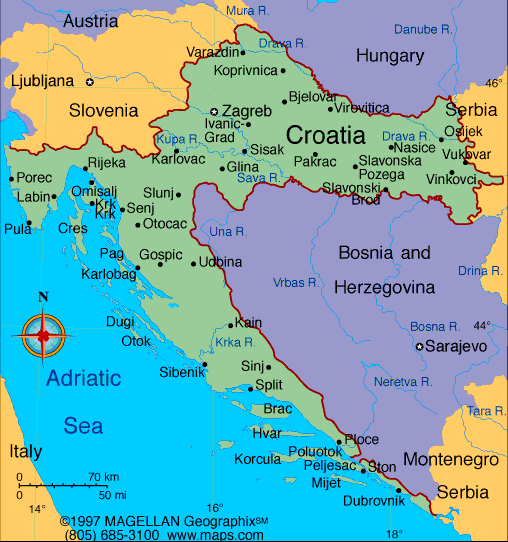CROATIA

Geography: Croatia is a former Yugoslav republic on the Adriatic Sea. It is about the size of West Virginia. Part of Croatia is a barren, rocky region lying in the Dinaric Alps. The Zagorje region north of the capital, Zagreb, is a land of rolling hills, and the fertile agricultural region of the Pannonian Plain is bordered by the Drava, Danube, and Sava Rivers in the east. Over one-third of Croatia is forested.
Government: Presidential/parliamentary democracy.
History: Croatia, at one time the Roman province of Pannonia, was settled in the 7th century by the Croats. They converted to Christianity between the 7th and 9th centuries and adopted the Roman alphabet under the suzerainty of Charlemagne. In 925, the Croats defeated Byzantine and Frankish invaders and established their own independent kingdom, which reached its peak during the 11th century. A civil war ensued in 1089, which later led to the country being conquered by the Hungarians in 1091. The signing of the Pacta Conventa by Croatian tribal chiefs and the Hungarian king in 1102 united the two nations politically under the Hungarian monarch, but Croatia retained its autonomy.
Following the defeat of the Hungarians by the Turks at the battle of Mohács in 1526, Croatia (along with Hungary) elected Austrian archduke Ferdinand of Hapsburg as their king. After the establishment of the Austro-Hungarian kingdom in 1867, Croatia became part of Hungary until the collapse of Austria-Hungary in 1918 following its defeat in World War I. On Oct. 29, 1918, Croatia proclaimed its independence and joined in union with Montenegro, Serbia, and Slovenia to form the Kingdom of Serbs, Croats, and Slovenes. The name was changed to Yugoslavia in 1929.
When Germany invaded Yugoslavia in 1941, Croatia became a Nazi puppet state. Croatian Fascists, the Ustachi, slaughtered countless Serbs and Jews during the war. After Germany was defeated in 1945, Croatia was made into a republic of the newly reconstituted Communist nation of Yugoslavia; however, Croatian nationalism persisted. After Yugoslavian leader Josip Broz Tito's death in 1980, Croatia's demands for independence increased in intensity.
In 1990, free elections were held, and the Communists were defeated by a nationalist party led by Franjo Tudjman. In June 1991, the Croatian parliament passed a declaration of independence from Yugoslavia. Six months of intensive fighting with the Serbian-dominated Yugoslavian army followed, claiming thousands of lives and wreaking mass destruction.

Map of Croatia
Republic of Croatia
President: Kolinda Grabar-Kitarović (2015)
Prime Minister: Zoran Milanovic
(2011)
Land area: 21,781 sq mi (56,414 sq km);
total area: 21,831 sq mi (56,542 sq km)
Population (2014 est.): 4,470,534
(growth rate: -0.12%); birth rate: 9.49/1000; infant mortality rate:
5.87/1000; life expectancy: 76.41
Capital and largest city (2011 est.):
Zagreb, 686,000
Other large cities: Split, 173,600;
Rijeka, 142,500; Osijek, 89,600
Monetary unit: Kuna
National Name: Republika
Hrvatska
Languages:
Croatian (official) 95.6%, Serbian 1.2%, other 3%
(including Hungarian, Czech, Slovak, and Albanian), unspecified 0.2%
(2011 est.)
Ethnicity/race:
Croat 90.4%, Serb 4.4%, other 4.4% (including Bosniak, Hungarian, Slovene, Czech, and Roma), unspecified 0.8% (2011 est.)
National Holiday:
Independence Day, October 8
Religions: Roman Catholic 86.3%, Orthodox 4.4%, Muslim 1.5%, other 1.5%, unspecified 2.5%, not religious or atheist 3.8% (2011 est.)
Literacy rate: 98.9% (2011 est.)
Economic summary: GDP/PPP (2013
est.): $78.9 billion; per capita $17,800. Real growth rate:
–1%. Inflation: 2.2%. Unemployment: 21.6% (2013). Arable land: 15.85%. Agriculture: wheat,
corn, sugar beets, sunflower seed, barley, alfalfa, clover, olives,
citrus, grapes, soybeans, potatoes; livestock, dairy products.
Labor force: 1.715 million; agriculture 2.1%, industry 29%,
services 69% (2012). Industries: chemicals and plastics,
machine tools, fabricated metal, electronics, pig iron and rolled
steel products, aluminum, paper, wood products, construction
materials, textiles, shipbuilding, petroleum and petroleum refining,
food and beverages, tourism. Natural resources: oil, some
coal, bauxite, low-grade iron ore, calcium, natural asphalt, silica,
mica, clays, salt, hydropower. Exports: $12.36 billion (2013 est.): transport equipment, textiles, chemicals, foodstuffs,
fuels. Imports: $21.74 billion (2013 est.): machinery,
transport and electrical equipment; chemicals, fuels and lubricants;
foodstuffs. Major trading partners: Italy, Bosnia and
Herzegovina, Germany, Austria, Slovenia, Russia (2012).
Communications: Telephones: main lines
in use: 1.64 million (2012); mobile cellular: 4.97 million (2012).
Broadcast stations: the national state-owned
public broadcaster, Croatian Radiotelevision (HRT), operates 4
terrestrial TV networks, a satellite channel that rebroadcasts programs
for Croatians living abroad, and 6 regional TV centers; 2 private
broadcasters operate national terrestrial networks; roughly 25 privately
owned regional TV stations; multi-channel cable and satellite TV
subscription services are available; state-owned public broadcaster
operates 3 national radio networks and 9 regional radio stations; 2
privately owned national radio networks and more than 170 regional,
county, city, and community radio stations (2012). Internet hosts: 729,420 (2012). Internet
users: 2.234 million (2009).
Transportation: Railways: total: 2,722
km (2012). Roadways: total: 29,410 km; (2011).
Waterways: 785 km (2009). Ports and harbors: Omisalj,
Ploce, Rijeka, Sibenik, Vukovar (on Danube). Airports: 69
(2013 est.).
International disputes:
dispute remains with Bosnia and Herzegovina over several small sections
of the boundary related to maritime access that hinders ratification of
the 1999 border agreement; since the breakup of Yugoslavia in the early
1990s, Croatia and Slovenia have each claimed sovereignty over Pirin
Bay and four villages, and Slovenia has objected to Croatia's claim of
an exclusive economic zone in the Adriatic Sea; in 2009, however Croatia
and Slovenia signed a binding international arbitration agreement to
define their disputed land and maritime borders, which led to Slovenia
lifting its objections to Croatia joining the EU; Slovenia continues to
impose a hard border Schengen regime with Croatia, which joined the EU
in 2013 but has not yet fulfilled Schengen requirements.
-------------------- o --------------------
No comments:
Post a Comment